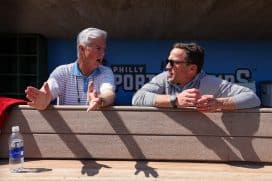Uncategorized
Flyers head coach Dave Hakstol Needs Total Buy-In to “Hard Hockey” Approach
The Philadelphia Flyers' marketing slogan for the 2015-16 season is "Play Boldly." If the off-season and pre-camp mantras espoused by new head coach Dave Hakstol and Ron Hextall are a reliable indicator of the messages that will be sent to the players throughout the season, expect a very heavy internal emphasis on Flyers players getting to the net and the lower slot in the offensive zone.
This is nothing revolutionary. Coaches at all levels of the game stress its importance, and former Flyers head coach Craig Berube spent much of last season opining that the team's spotty five-on-five scoring was a mater of not enough Flyers players getting the puck and bodies to the net. Throughout the game, buzz phrases such as "greasy goals" and "compete level" have almost become clichés to some extent.
In this case, the cliché of actions speaking louder than words rings true. A big part of the reason why Hextall hired Hakstol in the first place is that he acquired a reputation at the University of North Dakota of holding players accountable to his system, which heavily emphasizes back pressure, puck possession and a belief that gritty goals rather than pretty goals are the key to consistent scoring.
Hakstol re-emphasized those points in an interview with NJ.com earlier this week.
"When you talk about scoring, you've got to go to the hard areas," said Hakstol. "We've got enough ability where we're gonna score some pretty goals, but if you want to score on a consistent basis, I think you've got to get to the hard areas consistently."
When Hextall had his recent pre-camp conference call with local reporters about his outlook for the season, he delivered the same message as the coach. He, too, used the term "hard hockey" — rather than saying "play boldly", but the implication is identical — the GM said that he feels Hakstol's system and personnel management style are conducive to getting the desired results, but the players much commit and make sacrifices. Specifically, the GM feels that it not only power forward types who are responsible for getting the high-punishment but high-reward spots inside the hash marks to the crease.
"We need to get to the net more. Whether it’s the smallest guy on the team or the biggest guy. A lot of goals are scored around the paint and we need to get to the net more. With things that I can view from his system, yeah I think we will be better. That’s what we’re banking on, but I think it somewhat comes down to the individuals," said Hextall.
Playing hockey this way comes at a premium price.
It means players must be willing to take a higher degree of physical punishment because opponents fight just as hard to defend the "hard areas" as the attacking team does to invade that real estate. It means that everyone has to be alert to the play, with a strong emphasis on puck support. It means the Flyers team collectively has to be better than it was last year at winning board battles and establishing a cycling game to wear down opponents and create turnovers and in-close scoring chances. It means Flyers defensemen have to establish themselves as threats to pinch in or get shots on net from the point to keep opposing teams from simply sealing off the slots because they have no fear of the D being activated.
In short, it's easy for players to talk about playing offensive "hard hockey" but it takes a lot of sweat, pain, mental alertness and physical execution to actually make it an integral part of the team's identity. There cannot only be a few players — such as power forward Wayne Simmonds and top line players Jakub Voracek and Claude Giroux — who play to those standards, because it won't work.
Specific to Hextall's point that even the smallest players on the ice can — and must — play that way, a good case in point would be to look at how Danny Briere scored so many goals in the playoffs. He had a knack for using the net as a "shield" or taking advantage of the diverted attention of a defender and quickly getting the area from the lower slot to the paint. He often took a heavy hit for his troubles, but the puck was also quite often going over the goal line by that point. A player such as newcomer Sam Gagner is capable of scoring more goals this way if he sets his mind to it.
Hextall has placed a vote of confidence in Hakstol that he can not install a system that emphasizes the key two-way traits it takes to win with greater consistency but can also get his players to buy into it. As the accountability message gets hammered home, expect the coach to make frequent repetition of the "hard hockey" terminology and for his level of satisfaction or displeasure with how the team is playing to be heavily based on the attention to detail the players pay to the many small-piece components that make up the big picture.












































